Comet NEOWISE Climbs Higher in Evening, a Perfectly Placed Moon for Evening Viewing, Mars before Midnight, and Seeing Planets Simultaneously!

This stunning image of Comet C/2020 F3 (NEOWISE) was captured in cottage country, near Haliburton, Ontario, by Kersti Meema of Toronto using her Canon T7i camera. She took the image at 11:15 EDT on July 13, 2020. Serendipitously, she also captured an auroral display! The fainter, blue ion tail of the comet can be discerned above the bright dust tail. The pair of bright stars at upper left are Alkaphrah and Talitha, the Great Bear’s front claw stars.
Hello, Comet Lovers!
Here are your Astronomy Skylights for the week of July 19th, 2020 by Chris Vaughan. Feel free to pass this along to your friends and send me your comments, questions, and suggested topics. You can also follow me on Twitter as @astrogeoguy! Unless otherwise noted, all times are expressed in Eastern Time.
I can bring my Digital Starlab portable inflatable planetarium to your school or other daytime or evening event, or teach a session online. Contact me through AstroGeo.ca, and we’ll tour the Universe or the Earth’s interior together!
We’ll get a few more good nights to see Comet NEOWISE in the NW evening sky below the Big Dipper. By mid-week the moon will be shining in the evening sky, too. Saturn will reach peak visibility at opposition on Monday, Mars will rise before Midnight, and all eight classical planets will be above the horizon at the same time in the pre-dawn! Here are your Skylights!
Bright Comet NEOWISE This Week
Comet C/2020 F3 NEOWISE will continue to be visible after sunset this week! It’s beginning to diminish in brightness – but you can still see it with your unaided eyes against a dark sky. All you will need are clear skies to the northwest and a view that is free of obstructing trees and buildings. If you live in an apartment with western or north-facing windows or a balcony, you’re in luck.
This comet looks its best when seen through binoculars. What you should expect to see is a small, bright, fuzzy spot, possibly with a greenish hue – and the comet’s faint tail extending generally upwards and to the right, away from the sun. Actually, look for two tails pointed in slightly different directions – a brighter one composed of debris the comet is dropping behind it, and a fainter, blue-tinted one composed of ionized gas. That second tail will always point directly away from the sun, since its being pushed by the solar wind. While your telescope will magnify the comet’s head nicely, its tail, which will extend beyond your limited field of view, won’t be as impressive.
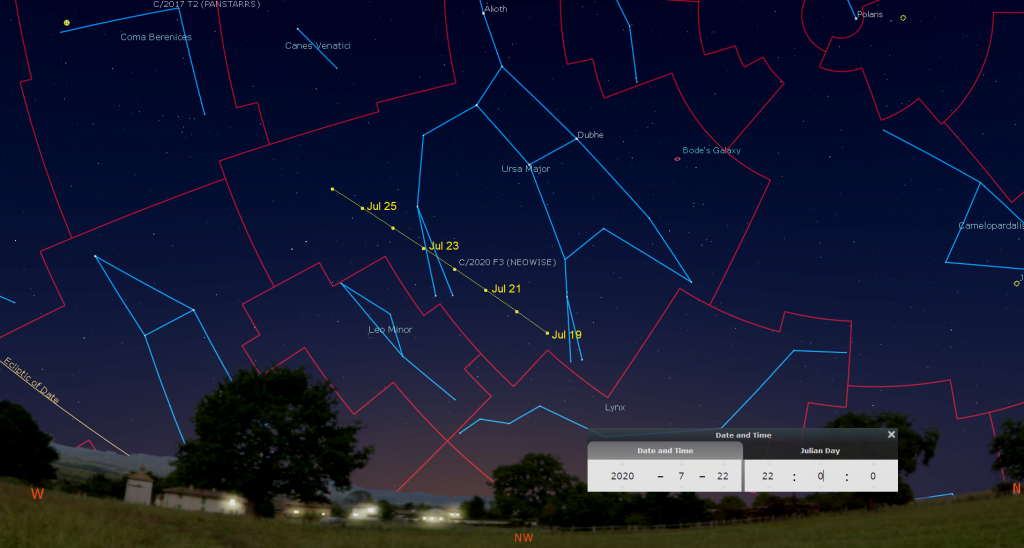
NEOWISE’s trajectory will bring it closest to the Earth (or perigee) at about 9 pm EDT on Wednesday, July 22, when it will be 103.5 million km or 0.692 Astronomical Units (1 AU is the mean Earth-sun separation) away from us. Unfortunately, as the comet nears Earth and looms larger, it will also be experiencing less heating from the sun, causing it to fade in visual brightness due to less gas production. It’s a trade-off that makes looking at the comet at the first opportunity your safest bet. What’s more, the pesky moon will return to the evening sky soon.
From our point of view on Earth, the comet is heading in a northwesterly direction – along the belly and legs of the Great Bear, Ursa Major. The northerly component of that motion has caused the comet to become circumpolar for observers living north of about 41° North latitude. That means it never drops below the horizon, but it also sits very close to the horizon during the night – making it best visible only during the post-sunset and pre-dawn periods. Even better, that northerly motion will also lift the comet nearly a thumb’s width (or 2°) higher every night, making viewing much easier.
As the sky darkens tonight (Sunday), the comet will become observable in binoculars after about 9:45 pm in your local time zone. At that time it will be about two fist diameters (or 20°) above the northwestern horizon (and even higher than that by next weekend), and descending. Once the sun has completely disappeared, you can safely sweep the sky for it with your binoculars. The comet is carried with the stars as the Earth turns. If you see something rapidly crossing the sky, it’s a plane or a satellite – such as the International Space Station.
After 10 pm, the comet will become visible without binoculars – if your skies are clear and not too light-polluted. The easy way to find the comet in evening is to look for the bright stars Dubhe and Merak high in the northwestern sky. They mark the bottom edge of the Big Dipper’s bowl. The comet will be directly below them on Sunday and Monday evening. If your view to the north is unobstructed, you should be able to watch the comet until at least midnight.
Each night this week the comet will shift left with respect to the dipper’s stars. On Wednesday, the night, when the comet is closest approach to Earth, the path of Comet NEOWISE will carry it just a couple of finger widths above a pair of medium-bright stars named Tania Australis and Tania Borealis. They form the bear’s rear paws. On the coming weekend – the comet will sit about 1.5 fist diameters to the lower left of the dipper’s bowl star Phecda.
Let me know if you see the comet, or get a photo of it! My friend Blake Nancarrow and I recorded a 35-minute video about finding, viewing, and photographing the comet. It’s on the RASC Toronto Centre’s YouTube channel here. I’ve also written an article about using mobile sky chart apps to find the comet. It should appear on www.space.com/skywatching within a day or so.
The Moon
This week, the moon will complete its monthly trip past the sun and return to view in the western post-sunset sky. When it reaches its new phase on Monday at 1:33 pm EDT (or 17:33 Greenwich Mean Time), the moon will be travelling between the Earth and the sun. Since sunlight is only shining on the side of the moon aimed away from us, and the moon is in the same region of the sky as the sun, the moon will be hidden from view everywhere on Earth for about a day.
Our first glimpse of the newly-minted moon will come just after sunset on Tuesday evening. At that time, the moon will display an extremely thin crescent all around the world – with only 2% of the moon’s disk illuminated. Once the sun has completely disappeared from view, it will be safe to search with binoculars for the moon sitting just above the west-northwestern horizon.
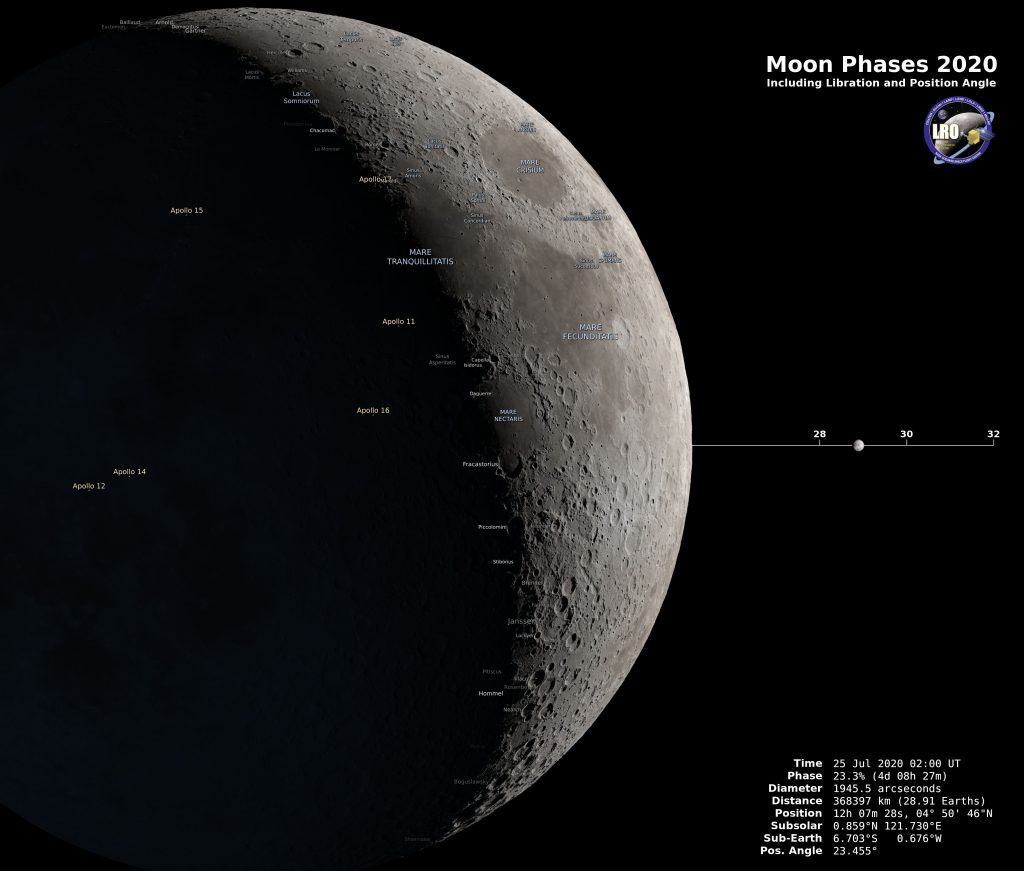
Seeing the moon will become far easier from Wednesday onwards. It will wax fuller and shift east every day – causing it to set longer after the sun and to shine higher in the western sky. On Wednesday and Thursday, it will pass through Leo (the Lion). The waxing crescent moon will spend the balance of this week in the large constellation of Virgo (the Maiden).
While the moon is marching towards next Monday’s first quarter phase, it will perfectly placed for evening viewing around the world – using your unaided eyes, or looking through binoculars and telescopes. As the moon floods with more and more light, the sun is slowly rising in the moon’s sky. The curved pole-to-pole zone that separates the lit and dark hemispheres is the terminator – the line of sunrise (or sunset) on the moon. The nearly-horizontal sunlight shining on the terrain near that line looks especially exciting under magnification. Choose a prominent, deep crater on the lit side, near the terminator. One night, it will have a dark, empty floor – the next, a central peak might catch the sun’s rays. And eventually, everything inside it will become fully illuminated. It’s fun!
The Planets
For the next ten days, the planet Mercury will be making an appearance over the northeastern horizon before sunrise. While this visit by Mercury isn’t especially good for those viewing it from mid-northern latitudes, it does set up a cool planetary event!

Just before 5 am in your local time zone, Mercury, Venus, Uranus, Mars, Neptune, Saturn, and Jupiter (in that order, from east to west) will all be above the horizon at the same time! Add in the Earth underfoot, and you’ve an opportunity to view all of the classical planets. Even Pluto will be there – quite close to Jupiter.
It will be a tough challenge to actually see all of those planets. The brightening sky will wash out dim Neptune – but a large telescope will do the trick, especially a computerized one. (Technically, you could view Neptune in a dark sky just after Mercury rises at about 4:30 am local time.) To see the entire set, you’ll need an unobstructed view of the northwestern horizon for Mercury and the same in the southwest for Jupiter and Saturn – plus clear skies in all directions. A south-facing balcony on a high floor would lend an advantage. Let me know if you see them!
Let’s break down the planet-doings this week. Elusive Mercury will climb a little higher every morning until Wednesday, when will reach a maximum angle of 20 degrees from the sun, and peak visibility for this morning apparition. Then Mercury will begin to descend sunward again. Look for the planet sitting very low in the east-northeastern sky between about 5 and 5:30 a.m. in your local time zone. In a telescope, Mercury will show a 37%-illuminated, waxing crescent phase. Mercury’s position below the morning ecliptic will make this apparition favours those located near the Equator, and farther south.
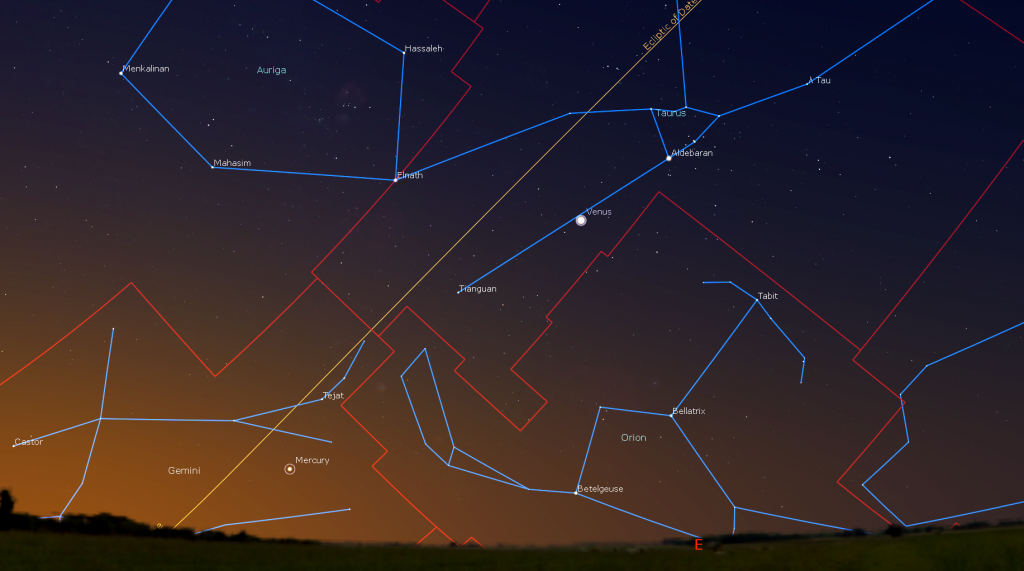
Early risers will be captivated by extremely bright Venus, which will rise in the east at about 3 am local time this week and remain visible until sunrise as it climbs the sky. Viewed in a backyard telescope at medium magnification, Venus will show the same crescent phase that Mercury has. Watch for the very bright, orange-tinted star Aldebaran in Taurus (the Bull) sitting a generous palm’s width to Venus’ upper right (or 8° to the celestial west).
Blue-green Uranus is rising shortly before 1 am local time this week. It’s visible with unaided eyes and in binoculars under a dark sky. Look for the magnitude 5.8 ice giant planet sitting in southern Aries (the Ram) – about a fist’s diameter below the ram’s brightest stars Hamal and Sheratan.
Next in line is Mars, which will put on a great showing come the fall! On Wednesday, the red planet will officially become an evening planet, when it begins to rise before midnight local time – yay! Mars is steadily increasing in disk size and brightness because Earth is travelling towards it. You can’t miss Mars – nothing else near it is anywhere as bright, nor as red. Mars will be visible as a prominent reddish dot until dawn, when it will be positioned about four fist diameters above the south-southeastern horizon.
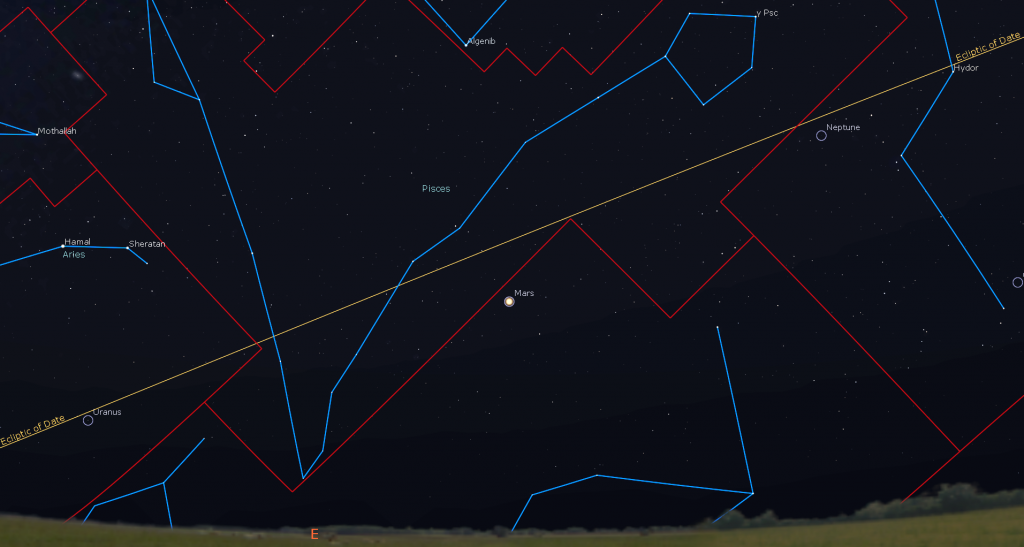
Dim and distant Neptune is located about 2.5 fist diameters to the right (or23° west) of Mars, among the stars of eastern Aquarius (the Water-Bearer). Neptune rises in late evening and then climbs higher until just before dawn, when you’ll get your clearest view of it, halfway up the southern sky. Neptune is hard to find without a computerized telescope. The nearest medium-bright star is Hydor, which is located a slim fist’s diameter to the planet’s right.
The evening planets are easy ones to see – Saturn and Jupiter! Somewhat dim, yellow-tinted Saturn is chasing brighter, whiter Jupiter across the night sky – lagging it by only a palm’s width among the stars of eastern Sagittarius (the Archer). Last Tuesday, the Earth passed between Jupiter and the sun, placing us closest to the giant planet for 2020. This week, it’s Saturn’s turn!
On Monday, July 20, Saturn will reach opposition – rising at sunset, and remaining visible all night long. At opposition, Saturn will be located 1.346 billion km, or 74.9 light-minutes from Earth, and it will shine at its maximum brightness of magnitude 0.13 for 2020. In telescopes Saturn will show its greatest apparent disk diameter of 18.5 arc-seconds – and its rings, which will be narrowing every year until the spring of 2025, will span 43 arc-seconds. (That’s about the same as Jupiter’s disk). A handful of Saturn’s moons are readily observable with backyard telescopes in a dark sky.
Don’t worry if you miss seeing Saturn on Wednesday. Planets at opposition are travelling parallel to the Earth – so their closeness and brightness last for many nights surrounding the peak.
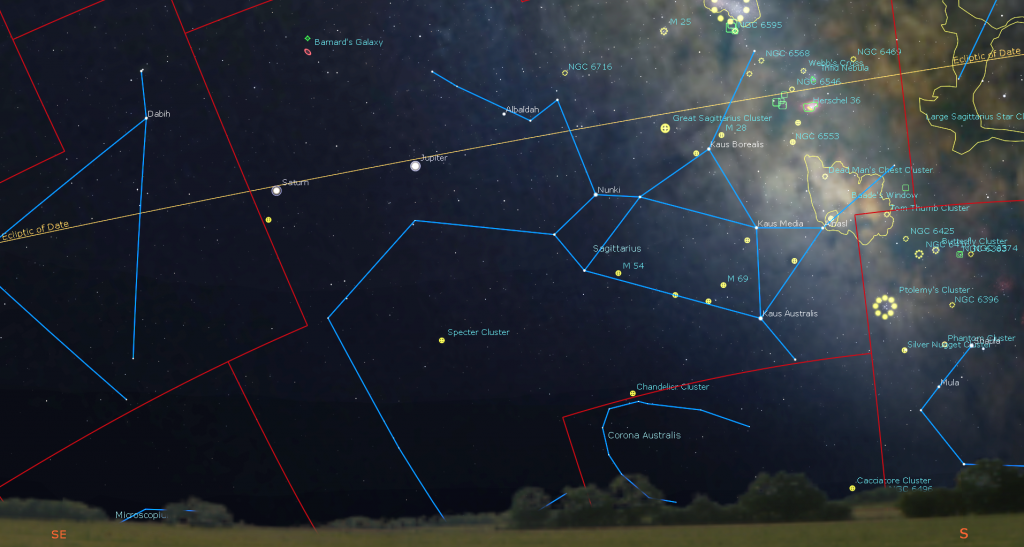
In recent weeks, Saturn has been positioned above a globular star cluster named Messier 75 (or NGC 6864). The magnitude 9.2 cluster will appear in binoculars and backyard telescopes as a small, fuzzy patch. This week, the cluster will be located approximately a generous thumb’s width below (or 1.5 degrees to the celestial south of) Saturn. Every night, the planet’s orbital motion will carry Saturn a little bit to the right (west) compared to that cluster.
Even a small telescope will show Saturn’s rings and several of its brighter moons – especially its largest moon, Titan! Because Saturn’s axis of rotation is tipped about 27° from vertical (a bit more than Earth’s axis), we can see the top surface of its rings, and its moons can arrange themselves above, below, or to either side of the planet. During this week in late evening, Titan will migrate counter-clockwise around Saturn, moving from the lower left of Saturn tonight (Sunday) to the upper right of the planet next Sunday. (Remember that your telescope will flip the view around.)
Turning to Jupiter, which will already be shining brightly in the eastern sky at dusk, good binoculars will reveal Jupiter’s four large Galilean moons named Io, Europa, Ganymede, and Callisto as they dance around the planet from night to night. Even a modest-sized telescope will show Jupiter’s brown equatorial belts and the famous Great Red Spot (or GRS, for short) is the air is steady. Due to Jupiter’s 10-hour period of rotation, the GRS appears every second or third night from a given location on Earth. In the Eastern Time zone, the Great Red Spot will be crossing the planet’s disk after dusk tonight (Sunday), on Friday, and next Sunday. It will also appear in late evening on Tuesday, and before dawn on Tuesday and next Sunday.
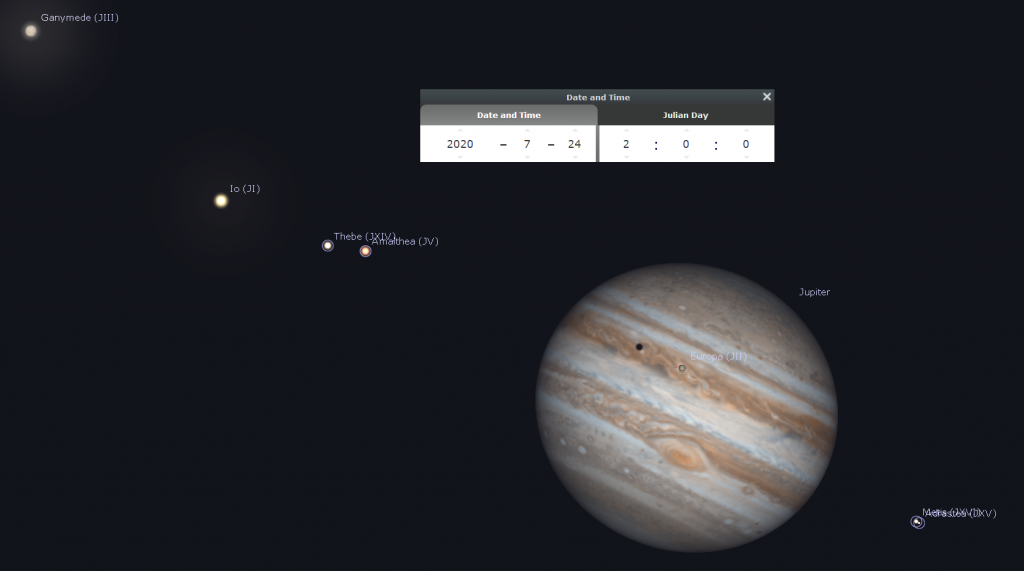
From time to time, the round, black shadows cast onto Jupiter by its Galilean moons are visible in amateur telescopes as they cross (or transit) the planet’s disk for a few hours. On Wednesday, Io’s shadow will cross Jupiter from 11:55 pm to 2:11 am EDT. On Friday, Europa’s shadow will join the red spot, already at mid-transit, at 1:18 am EDT (or 05:18 GMT). The spot will vanish around Jupiter’s edge at about 3:40 am EDT, leaving Europa’s shadow to complete its passage about 25 minutes later. On Saturday, Callisto’s large shadow will cross Jupiter’s northern hemisphere from dusk until 12:45 am EDT on Sunday.
Last week, the dim and distant dwarf planet Pluto also reached opposition for 2020. On that date, Pluto was located 4.91 billion km, or 273 light-minutes from Earth. Its extremely faint visual magnitude of +14.2 is far too dim for visual observing through backyard telescopes; but the planet will actually is located in the sky two finger widths to the lower left (or 2.25° to the celestial southeast) of Jupiter. Even if you can’t see Pluto directly, you will know that it is there.
Public Astro-Themed Events
Every Monday evening, York University’s Allan I. Carswell Observatory runs an online star party – broadcasting views from four telescopes/cameras, answering viewer questions, and taking requests! Details are here. Their in-person Wednesday night viewing has been converted to online via the observatory Youtube channel, where they offer free online viewing through their rooftop telescopes, including their brand new 1-metre telescope! Details are here.
My Insider’s Guide to the Galaxy webcasts with Jenna Hinds of RASC National will continue on Tuesday, July 28 from 3:30 to 5 pm EDT. Details and the schedule are here. In the meantime, join Jenna and John Reid on Thursday, July 23 at 3:30 pm EDT. They’re running through the RASC’s Explore the Universe certificate.
The Canadian organization Discover the Universe is offering astronomy broadcasts via their website here, and their YouTube channel here.
On many evenings, the University of Toronto’s Dunlap Institute is delivering live broadcasts. The streams can be watched live, or later on their YouTube channel here.
The Perimeter Institute in Waterloo, Ontario has a library of videos from their past public lectures. Their Lectures on Demand page is here.
Keep looking up, and enjoy the sky when you do. I love questions and requests. Send me some!